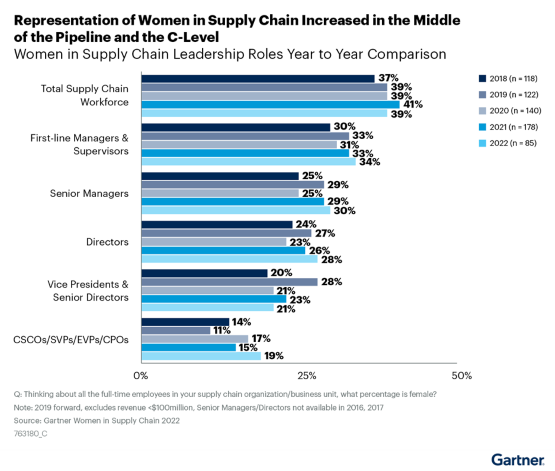Gartner survey finds increased representation of women in supply chain leadership roles
However, slight dip in women in VP-level roles, while research also found retaining midcareer women hinges on advancement opportunities and pay equity

In 2022, women account for 19% of C-level positions in the average supply chain organization, up from 15% in 2021, according to a survey by analyst company Gartner, and AWESOME, an organization that focuses on advancing women’s leadership in supply chains. However, women comprise 21% of VP-level roles, a decrease from 23% last year, and 39% of the total supply chain workforce are women, down from 41% in 2021.
“Chief supply chain officers (CSCOs) remain committed to gender diversity, but this survey suggests that they will need to double-down on goal setting, leadership inclusion and career-pathing for women,” said Caroline Chumakov, senior principal analyst with the Gartner Supply Chain practice. “Compared to the last year, representation of women in supply chain has improved at the first-line manager/supervisor, senior manager and director levels of the supply chain organization, as well as at the senior-most level: the C-suite.”
The Women in Supply Chain survey was conducted online from February 24 through March 28, 2022, among 116 respondents primarily in North America. Of the 116 respondents, 85 were end-user organizations with internal supply chains, and 31 were supply chain business services and solutions. Organizations also had to have a minimum of $100 million in annual revenue.
There is a relationship between organizational size and purposeful goal setting which is driving improved representation of women in supply chain, according to Gartner. Nearly 50% of medium and large organizations ($100 million to $5 billion) have no objectives to increase the number of women leaders in their supply chain. However, 83% of the largest, global organizations ($5 billion+) have a stated objective to improve representation of women in leadership and 38% have incorporated formal targets that appear on management scorecards.
“Global organizations have better pipelines and better representation of women underrepresented races and ethnicities,” said Chumakov. “They are also significantly more likely to have these women in a director position than medium or large organizations.”
Supply chain leaders who have seen improvements in gender-balanced representation in their organization should not become complacent in their efforts, Gartner added. Forty-three percent of supply chain leaders say the pandemic has had a net negative impact in the retention and progression of women in supply chain organizations over the past year. This is a significant uptick compared to the 2021 survey, where only 11% said there was a negative impact. Over half of end-user organizations state retaining midcareer women is an increasing challenge, with an additional 19% indicating it is a significant challenge.
According to end-user respondents, the top reason that midcareer women are leaving is because they lack career or advancement opportunities - an increase from last year’s responses. The fastest-climbing response is that women are seeking greater or more competitive compensation, coming in at second place with 43% of responses, up from 24% of responses in 2021.
Financial implications remain largely unaddressed by supply chain organizations. Only half have a targeted initiative focused on improving benefit offerings for women or closing the pay gap. Among those end-user organizations who say it is an objective, 27% report that they have a specific plan to close the gender pay gap.
“While 14% of end-user organizations stated they’ve already achieved pay equity, it is concerning that 59% of respondents have no action plan to close the gap. In today’s hypercompetitive labor market where women are increasingly seeking out pay increases and ethical employers, these data points reveal a hidden attraction and retention risk,” Chumakov concluded.
Gartner clients can read more in “2022 Women in Supply Chain Survey Reveals Midpipeline Progress and Global Organizational Prowess.” Non-Gartner clients can listen to the complimentary webinar.

Article Topics
Gartner News & Resources
Gartner foresees sizeable uptake for next-gen humanoid robots Gartner survey finds 49% of supply chain organizations have formal DEI objectives The pluses propelling cloud warehouse management systems (WMS) Gartner: 26% of supply chain C-suite roles now filled by women What’s keeping the supply chain C-Suite up at night? Materials handling robot basics Talking Supply Chain Podcast: Insights on leaders: The Top 25 More GartnerLatest in Materials Handling
The (Not So) Secret Weapons: How Key Cabinets and Asset Management Lockers Are Changing Supply Chain Operations MODEX C-Suite Interview with Harold Vanasse: The perfect blend of automation and sustainability Consultant and industry leader John M. Hill passes on at age 86 Registration open for Pack Expo International 2024 Walmart chooses Swisslog AS/RS and software for third milk processing facility NetLogistik partners with Vuzix subsidiary Moviynt to offer mobility solutions for warehouses Materials Handling Robotics: The new world of heterogeneous robotic integration More Materials HandlingSubscribe to Materials Handling Magazine

Find out what the world's most innovative companies are doing to improve productivity in their plants and distribution centers.
Start your FREE subscription today.
April 2024 Modern Materials Handling

Latest Resources










